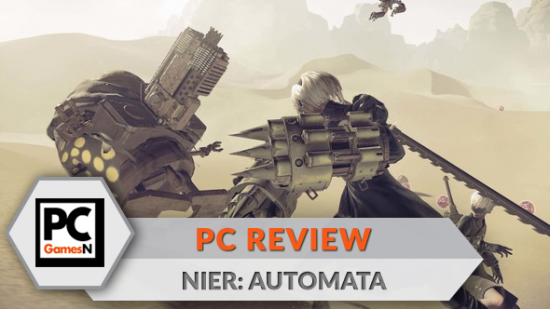When I first previewed Nier: Automata, I was apprehensive. The combat was the brilliant business-as-usual for Platinum Games, but the stark open-world design felt restricted and far removed from the vast cornucopias we’ve seen in recent years. Now however, playing the game in full, I quickly learned that Nier: Automata is a game not so much full of surprises as one that’s outright defined by them, sweeping breathlessly through different genres, narrative twists and fourth-wall breaks with the effortlessness of an android ninja blade slicing through the rusted iron body of a robot. The open world isn’t really the point here.
Related: still hungry for weird? Try these PC indies.
Automata’s mechanics feels like a natural evolution of Platinum Games’ already excellent action formula as seen in Bayonetta, Metal Gear Rising: Revengeance and, errr, Teenage Mutant Ninja Turtles, but the game also marks a maturation of sorts for visionary oddball Yoko Taro and his long-running yet never that great Drakengard series (and their spin-off, Nier, to which this is a vaguely related sequel). At long last, Taro’s trademark weirdness, thoughtful philosophical narratives, and genre-smashing gameplay have fused together harmoniously in the hands of Platinum Games, amounting to one of the most original games of recent years.
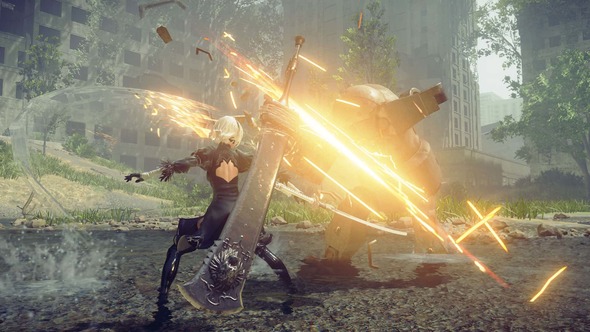
You are YoRHa No.2 Type B (2B for short), a platinum-haired combat ninja android with that traditional combat ninja android get-up consisting of a revealing, highly tearable skirt, suspender tights, and cleavagey top. She’s a soldier for YoRHa, an android army tasked with fighting machines that pushed humans from the planet thousands of years ago. The machines were commissioned by an invading alien race, while the androids are fighting on behalf of faceless humans who are floating around in space while you do their dirty work. Accompanying you in the fight is boyish, schoolboy-shorted scout android 9S, who fights alongside you throughout most of the game.
Nier: Automata is, at its heart, about the relationship between these two androids and their growing emotional dependance on each other in a melancholy, desolate world. Their bond is at once adolescent and incredibly adult, as they are doomed to fight and fall in perpetuity, with their memories getting loaded from one android chassis to the next upon death. 9S’s disarming curiosity about the world and desire for friendship slowly chips away at 2B’s austere, task-at-hand veneer, and the whole thing almost feels like a high-school rom-com about the sweet, geeky kid charming the initially stuck-up cheerleader, albeit while slaying endless waves of tin-pot robots, and with a far more tragic undercurrent.
But there’s more to these rusty, retro and rather cute ‘bots than you first assume, and what starts off as a fairly typical battle-against-the-machines scenario quickly builds in complexity. Supplemented by a hypnotic soundtrack, there’s a haunting tranquility to Automata’s post-human world; flora flourishes in the fecund city ruins (which give a whole new take on the phrase ‘urban jungle’), and the wildlife – boars and moose, mostly – has grown gigantic (and rideable, noteworthy if for no other reason than ‘fun’). When 2B is surprised to see a flock of birds fly across the sky, 9S says that their resurgence is thanks to the fact that there are no people, suggesting that while the world may be post-apocalyptic, there’s a purity to it, and a sense that maybe the ‘bots are better Earth-carers than humanity – a welcome twist on the usual ‘humanity must prevail’ shtick.
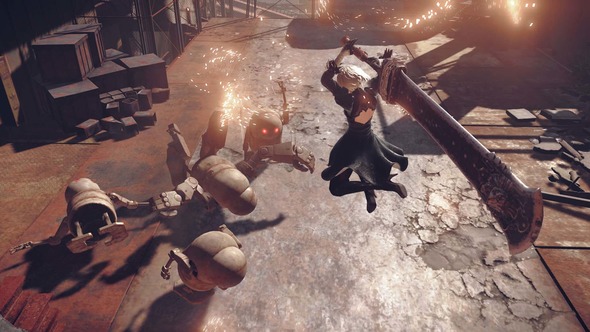
Automata’s world has more in common with Zelda or a 3D platformer than The Witcher III, with distinct areas and biomes branching off from a large barren central expanse of City Ruins in the middle. It’s not so much a world as a city and its suburbs, and is designed more with atmosphere than endless exploration in mind. Most of the quests you receive will be from the hubs of the various factions – human resistance fighters, pacifist machines living in treehouses, or your fellow androids – who task you with pleasant if simple tasks. Standout missions among these include whimsical races against a flying robot, and showdowns with rogue Yorha agents who imply that maybe you’re not working for the good guys after all. These tasks serve as gentle distractions from the compelling main quest, rather than deep sub-narratives unto themselves.
The ‘Taro’ mark of inimitable weirdness may not be familiar to lifelong PC gamers, so I’ll sum it thusly: fourth-wall trickery, genre-bending, clever meta-narratives, and a healthy sprinkling of androgyny. It’s this sort of stuff that’s earned the guy’s games a cult following, earning him a rep as a maverick of the industry. We see this in the fluidity with which Automata switches from its primary third-person perspective to, at various points, a shmup-like flying game, a crate-pushing puzzler, a 2D platformer (complete with conveniently-switched 2D mini-map) and a hacking mini-game. All these elements are implemented and integrated brilliantly, gliding from one to the next as elegantly as 2B sprints across the city ruins. There are technically 26 endings to the game, though the vast majority of them are, essentially, piss-takes. One example is removing 2B’s memory chip, which instantly fades the screen to black, while an incident with a certain type of fish can also lead to the credits rolling in a comical and abrupt conclusion. Classic Taro.
But it’s not just weirdness for its own sake, as much of it feeds into Automata’s themes of death and reincarnation. Anyone who’s played the demo will know that it more or less starts with 2B and 9S dying – their memory data then getting uploaded to their homebase where they are reincarnated in new bodies. There is also a somewhat Soulsian death system whereby the corpse of your previous incarnation stays at the spot you fell, and you can either retrieve it to regain the skill loadouts you set up for 2B, or resurrect it to temporarily fight alongside you. Likewise, you can do the same to the corpses of other players, as well as praying to give them HP boosts in their own games.
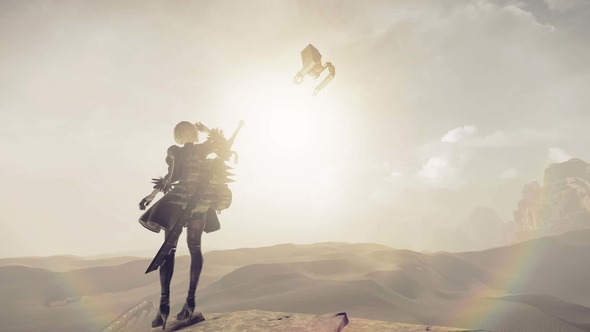
Each element in Automata feels cleverly diegetic. The entire UI in the pause screen, for example, is treated as 2B’s internal memory, where you can check the map, your quest log, as well as experiment with your weapon and skill loadouts. Your skills are managed using plug-in chips, and while the screen may look intimidating at first, it’s actually an ingenious way to distribute stats that will dramatically impact how you play. You can, for example, use the nearly game-breaking combination of ‘Offensive Heal’ and ‘Deadly Heal’, which encourages a Bloodborne-style approach by rewarding you with health for damage you do and enemies you kill. On the other hand, you could throw in the ‘Counter’ chip, which adds a counter-attack to your move-set, or simply build up your defence and stagger resistance to become a tanky-type character. Chips can be improved by fusing them, and you’re given a few load-outs to switch between for different situations.
On the weapons front, you can have two sets of two weapons each – one wep for your standard attacks and one for your heavies. There are tens to choose from, each with its own beautiful set of absurd animations consisting of such things as boomeranging greatswords, cartwheeling spear attacks, and the classic ‘stay suspended in the air by the momentum of your weapon’ attacks that those who have played the likes of Revengeance and Devil May Cry will quickly recognise. Many of the resources required to upgrade weapons don’t cross over either, encouraging you to experiment with different loadouts based on whims as simple as ‘those gauntlets look nice,’ or ‘that spear is so me, y’know?’
Combat itself is fast, ludicrous, and based around combos, dodging, and devastating counter-attacks. The robots give convenient visual and acoustic tells for when they’re about to attack, so even when the screen turns into a jumble of explosions and swinging weaponry, you can usually dodge your way out of trouble before leaping back in to cause some trouble of your own. Both you and 9S are accompanied by a pods, which have basic ranged attacks as well as special attacks that summon holographic-looking giant hammers, spears and other pseudo-medieval weapons of the future. All of it is, as you’d expect from Platinum, stylish and incredibly satisfying, while compromising some of the combo complexity of their previous, more action-oriented games.
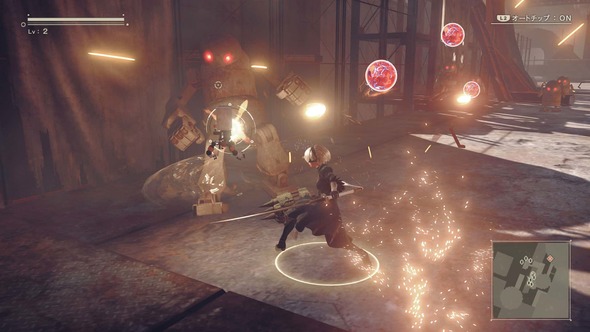
Taro is a designer who revels in surprises, but these go beyond the nudges and the winks and permeate the narrative itself. Returning to Automata’s Zelda connection, each new area is introduced by a long shot, a title card, and the first beats of the area’s theme tune. You can turn a corner from city ruins, and stumble into in an amusement park that’s been revived by machines firing confetti, balloons and fireworks, or descend a quarry to be met with the macabre sight of those tin-can machines imitating the act of sex as part of their learning of human behaviours (inevitably, they’re not very successful). Beats like these build up a great sense of pacing in Automata, its playfulness ensuring that it’s never just going through the motions of combat – which, no matter how brilliant, could easily have become tiring in a game like this.
Perhaps the greatest trick those devilish devs pulled is in Automata’s replayability. I’ve never really been one for slogging through a game twice, but when the credits rolled after my first playthrough, I was presented with a message more or less pleading me to have a second go. Ever the sucker for a good grovel, I bit, and found that the playthrough offered a new perspective on events, complete with new mechanics, new cut-scenes, and whole new gameplay sequences. The third playthrough is even more distinct, essentially marking the true final chapter of the game. Each run carries over skills and levels from the last, and while a single run offers a perfectly poignant and satisfying conclusion, there is much more here if you keep going.
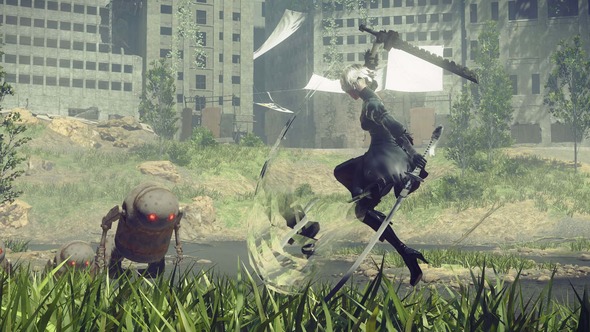
Platinum Games don’t have much experience in open-world design, and at times this showed, with some levels such as the Flooded City and Castle having distinct dead ends that you then have to run all the way back through when you complete them. Yes, you can unlock save stations that facilitate fast travel, so this never feels too egregious, but it still points to an area of design that the devs are acclimatising to. There have also been quite a few complaints about the game’s PC performance, with resolutions not scaling properly, 60fps frame caps, and full-on GPU crashes – particularly with AMD cards. Sadly, my rig wasn’t quite up to testing that 60fps limit, nor did I experience the other problems myself (editor’s note – we’ll be testing the game on a variety of GPUs in the near future). To their credit, Platinum Games responded almost straight away with a patch fixing the crashes, so hopefully it’s a case of a shaky start rather than anything causing long-term damage to the enjoyment of the game.
In a way, the quirky ingenuity of Yoko Taro is a perfect match for the zany style of Platinum Games. Both have a propensity for weirdness, and while Platinum have arguably been lacking originality in their all-action formula in recent years, Taro-conceived games never previously had the mechanics to cut it among the very best. Nier: Automata is something of a breakthrough for both parties; an intelligent, bombastic game that’s in turns frenetic and tender, while deviating from cliche at every opportunity (with the notable exception of the camera wantonly glimpsing the panties of its mildly fetishistic protagonist).
For all its use of gaming genres gone by, Nier: Automata has also delivered plenty of ideas for future games to chew on, experimenting with narratives in ways only possible in this strange medium of ours.Here’s hoping this is the start of a beautiful development relationship between some of the finest, most twisted minds in the industry.
